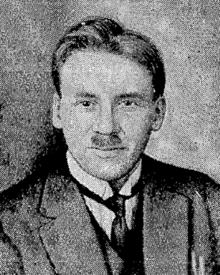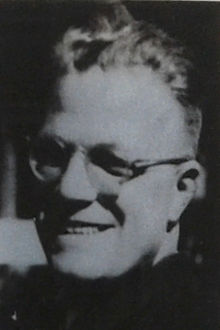Alsatia publishing house
The Alsatia publishing house was a publisher based in Colmar , the 1897-2000 works in High German , Alsatian dialect and French publications. Especially after 1945, publications appeared under the publisher names Édition Alsatia or Éditions Alsatia .
The enterprise

Alsatia-Verlag reached its greatest expansion in the 1930s with up to 500 employees. The publishing house was in Bartholdi Street in Colmar . The publishing house also had a printing shop and a bookbindery. One point of sale was on rue des Têtes ( head carriage ) in downtown Colmar. The publishing house had agencies and institutions in other places in Alsace, as well as an agency in Paris .
Publication history
The Alsatia publishing house published newspapers and magazines, e. B .:
- Alsatian courier (subtitle: Le Courrier d'Alsace ), Alsatia-Verlag, Colmar 1887–1940 (6 times a week, with inserts)
- The homeland - monthly for Christian culture and politics - Revue régionale d'Alsace et de Lorraine , Soc. d'Ed. Alsatia, Schlettstadt 1921–1939
- New Alsatian calendar. Illustrated house and homeland book for the Christian people , Alsatia, Colmar 1927–1942 and 1946–1980
- New and improved perfect state calendar called the Hinkende Bote (later: The Kolmar limping messenger ), Alsatia, Kolmar 1925–1942
Interwar period (1918–1939)
After the First World War , numerous plays appeared in the Alsatian dialect . In addition, books on religious, landscape, cultural and regional topics were published.
In the political disputes of the 1920s and 1930s, Alsatia-Verlag was an important publication location for the Alsatian autonomy movement . The publisher's newspapers and magazines published articles, but also brochures and books such as B .:
- Wilhelm Bruckner: Volkstum u. Language conditions in Alsace-Lorraine - expert opinion, only occasionally of the trials against the officials who have signed the manifesto of the Heimatbund. Alsatia, Colmar 1926.
- The Colmar conspiracy trial from May 1st to 24th 1928. Collected negotiation reports (in 4 editions). Alsatia publishing house, Colmar 1928
- Joseph Rossé (ed.): Alsace from 1870–1932 . Volumes I to IV, Colmar 1936
In October 1937 it was published in Paris
- Georges Cerbelaud-Salagnac: Sous le signe de la tortue. Legends indienne . Éditions Alsatia, Paris 1937
It was the first book from the collection Signe de piste , a very successful youth book series for many years , which mostly deals with the experiences and trips of scouts from the Bund . German translations of the "tracing books" appeared from 1948, first in the Alsatia publishing house in Colmar, and from 1959 in the Alsatia Freiburg branch .
Under German occupation (1940–1944)
Alsatia-Verlag was the only publisher in the Third Reich (and Alsace) between 1940 and 1945 that was still allowed to publish religious writings. This was mainly due to the position of the publisher's director Joseph Rossé , who, as a former “ Nanziger ”, was considered a martyr for Alsace by the National Socialists . During the German occupation of Alsace (1940–1944), people who were politically unpopular were accommodated at Alsatia-Verlag, such as For example, several school sisters from Rappoltsweiler , who had been banned from running their schools by the German authorities, and the banned German journalist Rupert Gießler , who was officially employed as a secretary in the publishing house, but performed the functions of a lecturer and department head. From September 1943, Jean Keppi was employed by Alsatia as the manager of the company's own print shop. The employees of the publishing house were seen as a sworn community. The Paris agency was upgraded to an independent publisher by the management so that it could continue to publish French-language publications as an Alsatian publisher. In order to be able to implement the publishing program, Rossé systematically circumvented the requirements of the occupation authorities. So were z. B. higher editions were printed than were approved or contracts backdated to times without restrictions. The dissemination of Reinhold Schneider's Sonnett collection Now is the Holy Time (1943) went under-hand; Each book was accompanied by a slip of paper that gave the impression that the work was out of print: "All orders from the publisher and bookstore are completely useless. They cause us a lot of work and under no circumstances can be done. As soon as the few remaining copies are available , their delivery takes place in the allocation procedure. Alsatia Verlag AG. "
Among the authors who were able to publish in Alsatia-Verlag during these years were v. a. Catholic opponents of the National Socialist regime:
- Reinhold Schneider (1903–1958), writer who is assigned to the internal emigration and belonged to the conservative Catholic Freiburg circle . Von Schneider published 22 titles by Alsatia Verlag, two of which were also in French at the publisher's Paris agency. A few of Schneider's books from this period have reached mass editions , such as The Lord's Prayer (first edition in 1941, then at least 3 further editions at annual intervals, a total of half a million copies) or The Way of the Cross (first edition in 1942, second edition in 1943, as well as a field edition for soldiers at the frontline).
- Alfred Delp (1907–1945), German Jesuit and member of the Kreisau Circle in the resistance against National Socialism
- Carl Muth (1867–1944), founder and long-time editor-in-chief of the Catholic monthly Hochland, which has been censored since 1933 and banned from 1941
- Theodor Haecker (1879–1945), Catholic writer and translator with contacts to the student resistance group White Rose, which has been banned from speaking and publishing since 1936
In August 1940 Rossé had to hand over the daily newspaper Elsässer Kurier to the National Socialist Phönix-Verlag, and other magazines had to be discontinued or were censored. According to Joseph Rossé, 6 titles with a print run of 34,332 books were published in the publishing house during the entire occupation, which served the interests of the German occupation. This was necessary to enable the other 230 publications, which together had a circulation of 3,106,009 copies and which were "grosso modo" directed against the Nazi government. Other sources, on the other hand, name a total circulation of two million.
After 1945
The publishing house was able to continue working immediately after the war ended. In the first post-war years, French-language titles dominated strongly. Since the 1950s, the proportion of German-language publications has been around half. From the 1970s onwards, the German-speaking share continued to decline. Most recently, only tourist guides were printed in German. Literature in the Alsatian dialect was rarely published; B .:
- Nathan Katz : O loos da Rüef dur d'Gàrte - nii Sundgäu poems. Editions Alsatia, Colmar 1958
- Henri Mertz: Kuddelmuddel üs' em Alsace (songs, verses and satire) . Éditions Alsatia, Colmar 1975.
The Alsatia Verlag then also published publications that would have been inconceivable under the autonomist Joseph Rossé - for example B. a benevolent work about Hansi (d. I. Jean-Jacques Waltz) , the vehement opponent of all German:
- Robert Perreau: Avec HANSI à travers l'Alsace. Ed. Alsatia, Colmar 1973 (Reprint 2000, ISBN 2-7032-0212-1 )
The last German-language publications of Alsatia-Verlag appeared in 1977 and 1978:
- Pierre Schmitt: The Unterlinden Museum in Colmar . 2., verb. Ed. (Guides artistiques de l'Alsace 1). Alsatia Publishing House, Colmar 1977.
- The Dominican Church in Colmar , Impr. Alsatia, Colmar 1978.
In the advertising campaign for the book published by Éditions Alsatia-Union in 1990
- Bernard Fischbach: Les Loups noirs - Autonomisme & terrorisme en Alsace . Alsatia-Union, Mulhouse 1990, ISBN 2-7032-0192-3 .
On the violent activities of the separatist group Black Wolves , a leaflet published by the publisher made a visual connection between terrorist acts and the work of the René Schickele Society . In a fast-track court proceeding initiated by the company, Éditions Alsatia-Union was sentenced to 10,000 FF compensation to the company and to the publication of a reply.
In 1998 and 2000, the last two publications by Alsatia were published as the takeover of older publications from another French publisher:
- Jeannine Siat: Histoire du rattachement de l'Alsace a la France . Alsatia Editions, Mulhouse 1998, ISBN 2-7032-0209-1 ("History of the connection between Alsace and France"; originally published by Horvath, Le Coteau 1987, ISBN 2-7171-0525-5 )
- Bernard Le Marec: L'Alsace dans la guerre 1939-1945 - la tentative de réannexion . Alsatia Ed. [Colmar] 2000, ISBN 2-7032-0211-3 ("Alsace in the war 1939–1945 - the attempt to reintegrate"; originally published by Horvath, Le Coteau 1988, ISBN 2-7171-0590-5 )
literature
In German language
- Rupert Gießler , Joseph Zemb: Witness in dark times. Joseph Rossé and the Catholic Alsatia publishing house 1940–1944. In: Christ in the Present . No. 43/1979 (October 28, 1979)
- Joseph Rossé: Journal of my Exile. In: Rot un Wiss. Le mensuel de tous les Alsaciens et des Lorrains Thiois. Monthly for Elsässer u. German Lorraine. reprinted in continuation between December 1993 (No. 195) and March 1996 (No. 220). Red and sc. Between 1975 and 2004 was a monthly in German and French in the tradition of the Alsatian autonomy movement.
- Jean-Jacques Ritter, Lucien Sittler : An Alsatian in the resistance against National Socialism. Joseph Rossé and the Alsatia publishing house. In: Book trade history. Published by the Historical Commission of the Börsenverein, 1982/2, p. B62.
- Hans-Joachim Koppitz: Reinhold Schneider, Heinrich von Schweinichen and Alsatia Verlag in Kolmar 1941–1945. In: Yearbook of the Silesian Friedrich Wilhelms University in Breslau. Volume 45/46 (2005), Degener, Insingen, ISSN 0448-1348 , pp. 519-540.
In French
- Gabriel Andres: Joseph Rossé - itinéraire d'un Alsacien ou le droit à la différence . Bentzinger, Colmar 2003, ISBN 2-84629-071-7 (“Joseph Rossé - the life of an Alsatian or the right to be different”)
Individual evidence
- ↑ Jean-Noël Grandhomme: La Congrégation des Sœurs de la Divine Providence de Ribeauvillé pendant la Seconde Guerre mondiale, 1939-1945 (last accessed on May 3, 2015; also printed under the same title in: Revue des sciences religieuses , 85/4 (2011), pp. 523-556, in French, summary also in English) only mentions that Rossé campaigned in vain with the German occupation authorities in 1940 for the evacuated nuns to return from the French southwest and for the resumption of teaching , but nothing of the employment of members of the order in the Alsatia publishing house (Chapter L'exil durable de certaines communautés en France , paragraphs 12 and 13)
- ^ Bernard Wittmann: Jean Keppi (1888-1967). Autonomist Chrétien Antinazi. Une histoire de l'autonomisme alsacien. Ed. Yoran Embanner, Fouesnant 2014, ISBN 978-2-36747-001-6 , pp. 263-264.
- ↑ cit. after Franz Anselm Schmitt (ed.): Reinhold Schneider - Life and Work in Documents. Walter-Verlag, Olten 1969, p. 145.
- ^ Grandeur de Corneille et de son temps and Chemin de croix , both 1943.
- ^ Theodor Haecker: The temptations of Christ ; Since the first edition of the essay in Alsatia-Verlag was destroyed by the effects of the war, the work was only published posthumously in 1946 in Berlin's Morus-Verlag; see Hinrich Siefken (Ed.): Theodor Haecker 1879–1945. Marbacher Magazin 49, 1989, p. 67.
- ↑ Joseph Rossé in a letter of October 19, 1945 to the French examining magistrate, cited above. with Gabriel Andres, Joseph Rossé - itinéraire d'un Alsacien ou le droit à la différence. P. 50.
- ↑ Rupert Gießler / Joseph Zemb: Witness in dark times. Joseph Rossé and the Catholic Alsatia publishing house 1940–1944. Jean-Jacques Ritter / Kucien Sittler: An Alsatian in the resistance against National Socialism. Joseph Rossé and the Alsatia publishing house.
- ↑ Between a picture of the car in which Hanns Martin Schleyer was found in Alsace after his assassination by the RAF in 1977 and another picture with reference to terrorism, the advertisement poster `` Lehr d'Kinder Elsässisch '' of the René Schickele Society was shown. Source: Land un Sproch No. 97, 1990, p. 4. Land un Sproch is the magazine of the René Schickele Society that appears 3 times a year.



